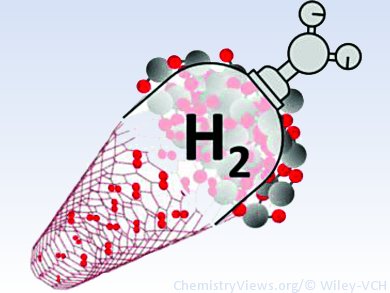Efficient and safe hydrogen storage is one of the most significant barriers to the widespread use of hydrogen as a fuel in many energy sectors. In conventional liquid-hydrogen storage, the pressurized metal tank accounts for more than 90 % of the total weight of the fuel. This more than neutralizes hydrogen’s high energy storage per unit weight. Carbon nanotubes are significantly lighter and have a great advantage as they are one of the strongest materials known, despite being only one atomic layer thick.
Recent results from Woon-Ming Lau, Ka-Wai Wong and co-workers, China Academy of Engineering Physics, Chengdu, demonstrate hydrogen storage and release inside nano-containers made from single-walled nanotubes. The nanotubes were used as tiny high-pressure gas tanks with the ends sealed by using plugs made of ice. A pressure of 5.0 MPa could be stored with no significant leakage and later released by simply heating the tubes to above the ice’s melting temperature.
According to theoretical calculations, carbon nanotubes in this configuration should be able to withstand 2 GPa of hydrogen pressure before they begin to leak. Even storage at 1 GPa corresponds to a weight-storage efficiency of approximately 9 %, close to the 2015 target from the US Department of Energy. If this can be realized, the next generation of hydrogen-powered vehicles may indeed have gas tanks made of carbon nanotubes.
- Realizing the Storage of Pressurized Hydrogen in Carbon Nanotubes Sealed with Aqueous Valves,
Changyu Tang, Changzhen Man, Yungui Chen, Fei Yang, Linshan Luo, Zhi-Feng Liu, Jun Mei, Woon-Ming Lau, Ka-Wai Wong,
Energy Technol. 2013.
DOI: 10.1002/ente.201300039




